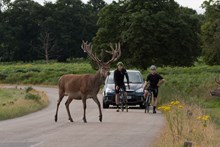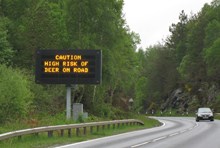11 May, 2017
High risk of deer on roads in May
A new report commissioned jointly by Scottish Natural Heritage (SNH) and Transport Scotland reveals collisions between vehicles and deer have increased by 10% in Scotland since previous figures were collated.
Motorists are being advised to slow down and be on the lookout for deer on the road, especially in May when incidents of deer-vehicle collisions (DVC) tend to increase as young deer disperse to look for their own territories. From Monday, May 15 to Monday, 5 June, SNH, working with Transport Scotland, have arranged warning messages to be displayed on variable messaging signs (VMS) on trunk roads across Scotland,
The VMS messages are targeted on roads with higher rates of deer-vehicle collisions, covering areas within the Central Belt around Glasgow and Edinburgh, as well as Stirling, Kinross, Perth, Dundee, Aberdeen and Inverness. The signs display the warning message: ‘Caution: high risk of deer on road.’
The report reveals that from January 2013 to December 2015, a sample of over 4,600 recorded collisions between vehicles and deer on Scottish roads were submitted to the project. However, taking into account the many incidents which go unreported, the report estimates that the true figure could be as high as 9,000 per year, resulting in 50 to 100 human injuries.
The highest number of collisions occurs in early evening through to midnight, with a slightly lower peak from 6 am to 9 am. The time of year when the highest number of incidents takes place is May and June, with high rates in autumn as well. The VMS campaign ensures that the warning messages are used during these times.
Over the past 50 years, wild deer in Scotland have increased their range and numbers by almost 50%, while the volume of road traffic has almost doubled in the same period. This combination has led to higher deer-vehicle collision rates across the country, with the greatest increase occurring in Aberdeenshire, Fife and the Central Belt. This corresponds with the rise in the populations of roe deer, which are highly adaptable to lowland habitats.
Jamie Hammond, SNH deer management officer, said:
"This report confirms what we suspected: that accidents involving deer are becoming more common as deer spread into new areas. For example, we are seeing more roe deer in the Central Belt with more trees being planted – a habitat which roe deer do well in.
"Particularly in peak times, we advise motorists to slow down and watch for deer crossing roads. Be aware that if you're driving near woods, deer can suddenly appear before you have time to brake. If you do hit a deer, report it to the police even if you’re uninjured and your car isn’t damaged, as the deer may be fatally injured and suffering."
Dr Jochen Langbein of the Deer Vehicle Collisions Project, who wrote the report for SNH, added:
“In Scotland, as in the rest of the UK and many other European countries, wild deer numbers have increased significantly over recent decades. Roe deer in particular have become well established in the urban fringe of many major towns and have also spread into parks and other green spaces close to the centre of cities such Glasgow, Aberdeen and Edinburgh. So although many people think most accidents with deer and vehicles occur on more remote Highland roads, in Scotland at least 40 percent occur on A-class trunk roads or motorways.”
The 2011 Wildlife and Natural Environment (Scotland) Act introduced a Code of Practice on Deer Management to help everybody who owns or manages land on which wild deer occur to deliver sustainable deer management.
Angus Corby, Transport Scotland Landscape Advisor, said:
“As the government agency responsible for the trunk road network, Transport Scotland requires our operating companies to prepare annual Deer Management Plans to take account of the likely impact of deer on the network and to develop possible mitigation strategies in association with adjacent local landowners. The annual VMS campaign, organised in partnership with our colleagues at SNH, forms part of this approach and is a useful means of ensuring road users are aware of the potential risk of wild deer crossing the road at this time of year.”
Driving tips to avoid deer include:
- Try not to suddenly swerve to avoid hitting a deer. A collision into oncoming traffic could be even worse.
- Only brake sharply and stop if there is no danger of being hit by following traffic. Try to come to a stop as far away from the animals as possible to allow them to leave the roadside without panic, and use your hazard warning lights.
- After dark, use full-beams when there is no oncoming traffic, as this will illuminate the eyes of deer on or near a roadway and give you more time to react. But dim your headlights when you see a deer or other animal on the road so you don’t startle it.
- Report any deer-vehicle collisions to the police, who will contact the local person who can best help with an injured deer at the roadside. Do not approach an injured deer yourself – it may be dangerous.
ENDS
Media queries - contact SNH media & public relations officer, Vicki Mowat, on 0131 316 2659 or vicki.mowat@snh.gov.uk (Tues to Fri) or the Inverness press office on 01463 725 022 (Mon).
Photo use: Please credit deer photos to Langbein Wildlife, and credit VMS roadside sign photo to Scottish Natural Heritage.
Contact information
- Name
- SNH Media
- snhmedia@snh.gov.uk
Notes to editors
The Deer Vehicle Collisions Project is attempting to build a full picture of deer-related motor vehicle accidents in the UK. For more information, see www.deercollisions.co.uk. Detail on how figures were determined is available in reports at http://www.deercollisions.co.uk/pages/latest.html
The study accrued and mapped in excess of 4600 new records of deer-vehicle collisions (DVCs) for the period from January 2013 to December 2015, which represents an increase of 10% on the previous three-year period. But, as there is no obligation on the public or organisations to report DVCs (except for those involving human injury), the numbers of records obtained only represent an annual sample of all DVCs that actually occur. To see the full report, go to http://bit.ly/2q5jVCq
NatureScot is Scotland's nature agency. We work to enhance our natural environment in Scotland and inspire everyone to care more about it. Our priority is a nature-rich future for Scotland and an effective response to the climate emergency. For more information, visit our website at www.nature.scot or follow us on X at https://x.com/NatureScot
’S e NatureScot buidheann nàdair na h-Alba. Bidh sinn a’ neartachadh àrainneachd na h-Alba agus a’ brosnachadh dhaoine gu barrachd suim a chur ann an nàdar. Tha e mar phrìomhachas againn gum bi nàdar na h-Alba beairteach agus gun dèilig sinn gu h-èifeachdach le èiginn na gnàth-shìde. Tha an tuilleadh fiosrachaidh aig www.nature.scot no air X aig https://x.com/NatureScot



